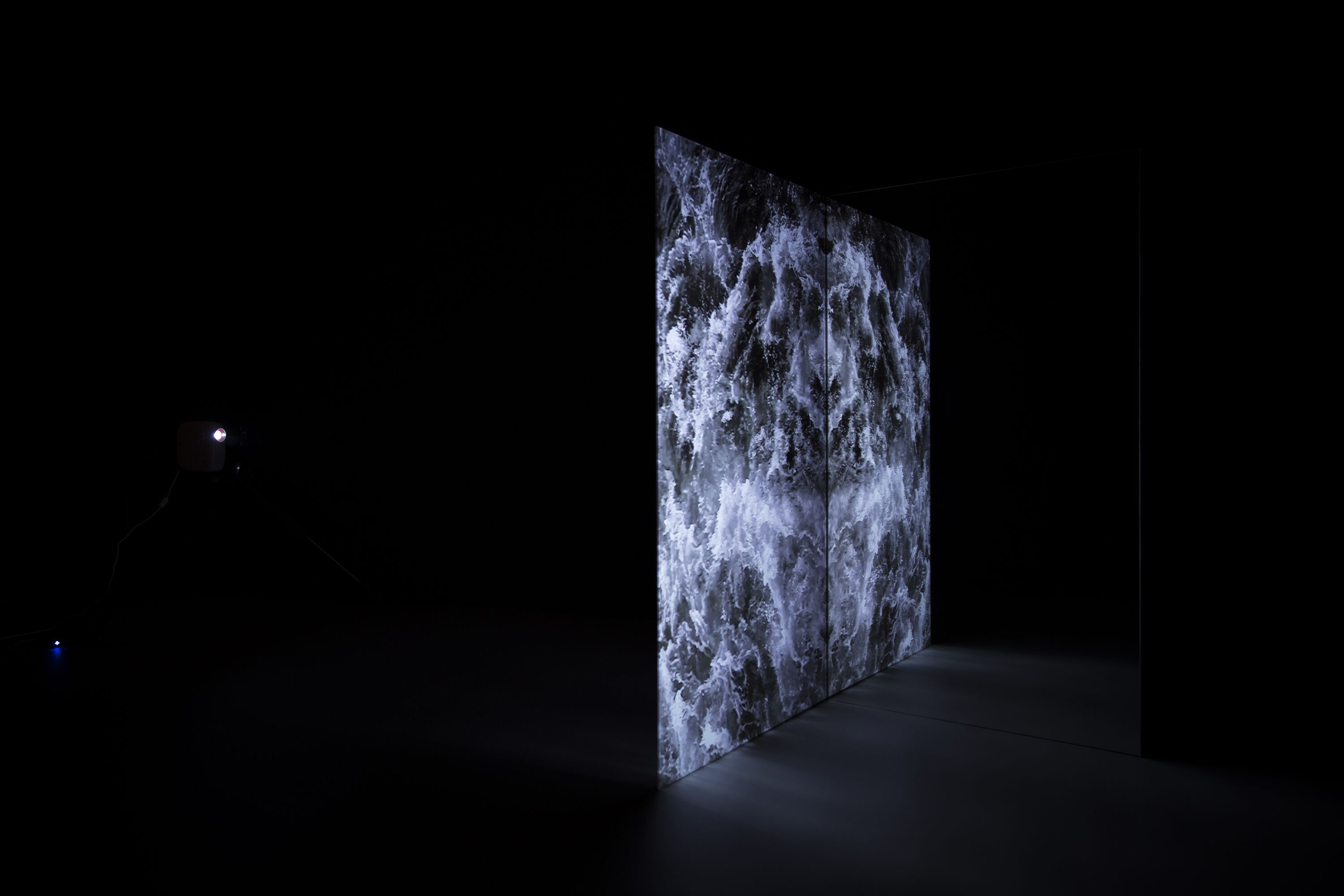
'Uncanny River (the crossing)'
This essay comes a few years after several public presentations of the video installation Uncanny River (the crossing) (2014–15), of which I am the author. My extensive involvement with audiences revealed their disquiet regarding the piece’s uncanniness and the illusory and perceptual phenomena that captivated them for a long time. The installation is composed of video recordings of a river seen from above, which is rear-projected onto a vertical sheet of glass reflected by a mirror set at a right angle, producing symmetrical compositions that continually dissolve and are replaced by an endless succession of new compositions.
‘To reach the Western Lands is to achieve freedom from fear. Do you free yourself from fear by cowering in your physical body for eternity? Your body is a boat to lay aside when you reach the far shore, or sell it if you can find a fool... it’s full of holes... it’s full of holes.’
William S. Burroughs (1987: 162)
Uncanny River (the crossing) (2014–15) is a video art installation projected onto a sheet of glass reflected by a mirror at a right angle. The result of this double projection and reflection structure produces a single image, an unbroken symmetrical and eccentric motion. The video records a river crossing seen from above. Water is the only visible element: its natural undulation is followed by churning caused by a boat engine. The boat itself is never seen, but its existence can be intuited—it is the boat that moves us across space and makes the camera move. Hence, it is the boat’s action that produces the camera movement and enables us (through the image of the water) to realize that we are crossing the river. The symmetrical duplication of the crossing forces us to simultaneously cross and return to the same bank from which we departed without actually noticing where we set off or where we are headed. It is as if we have always been there and could stay there forever, with no beginning or end, like the universe itself and all the universes before and after—facing the hypnotic double movement of the water and over the water. The singular construction of this moving image, which uses a projection and reflection system with a mirror, makes this simultaneous movement come true despite its being impossible in the physical world.
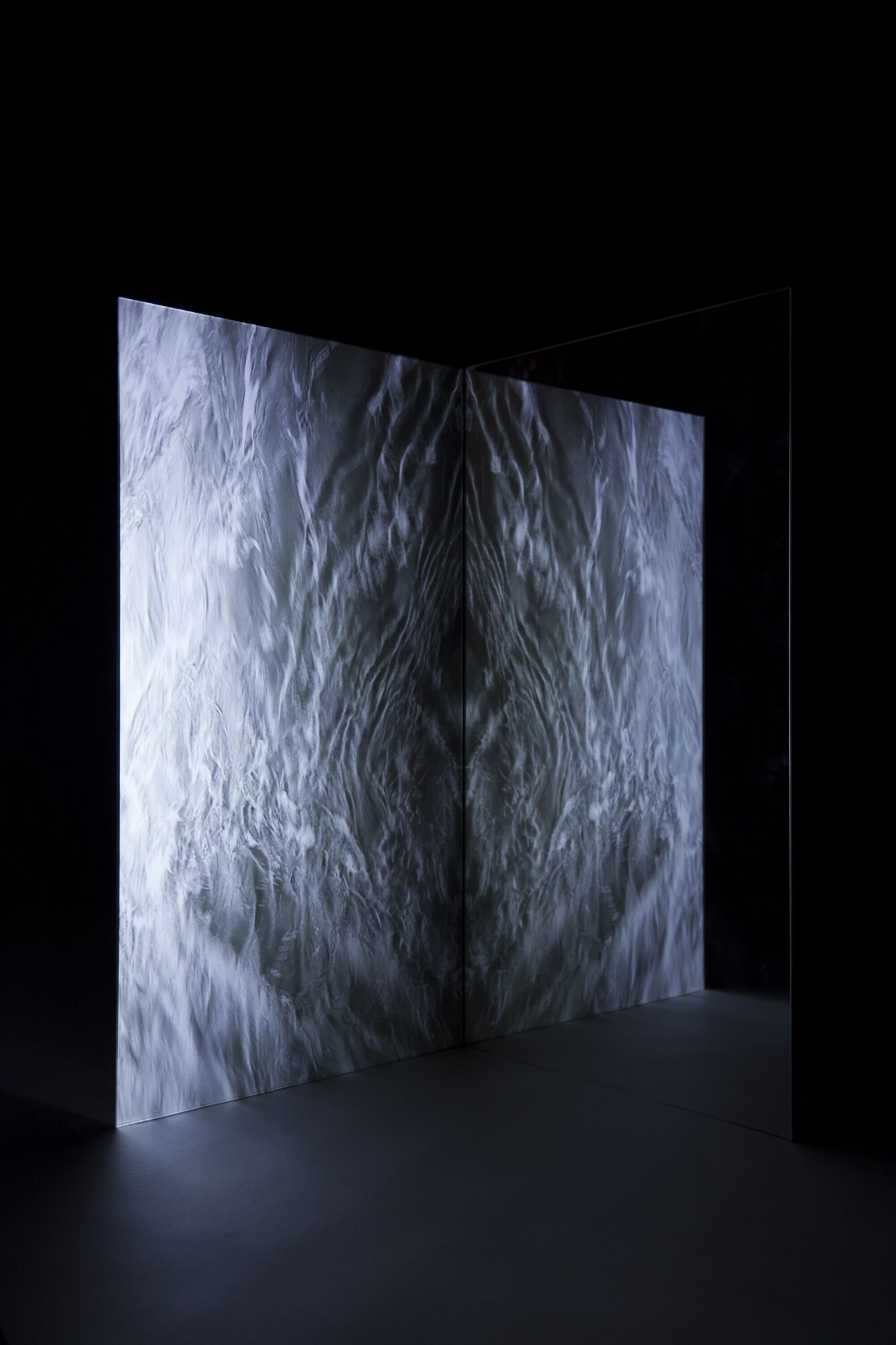
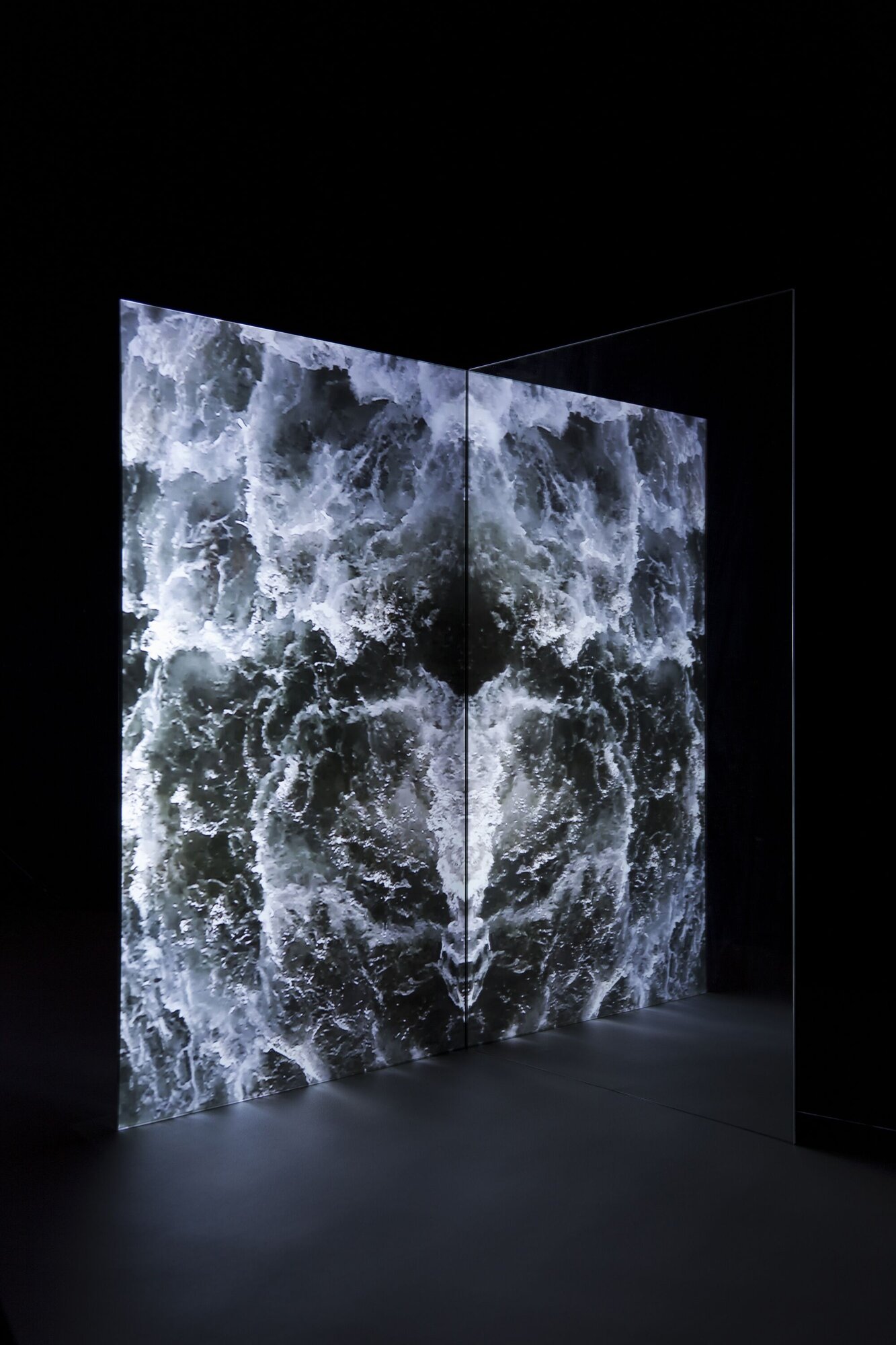
When I first placed a mirror perpendicular to the video screen during the process of creating Uncanny River (the crossing), the mere recording of the footage became a real event. Mirrors have always had the magic of making us aware of our existence; they always reflect what is there around us. Hence, the object that is reflected acquires the quality of a real thing. This consciousness is triggered in part by the framing of the reflected portion of space, but mostly by the instantaneous duplication of our bodies in that moment and space where they are. Mirrors make us look attentively at what lies on the other side, which simultaneously means being aware of this side, as if we did not belong to that space—and therefore as if we did not belong to the space in which we are either. As viewers, because we are inside the mirror as well, we are spectators of ourselves and of our world, confronted with our own gaze, that of the eye that sees that it is being observed by itself. The mirror positions us in a non-place in the physical sense and prevents us from fully immersing ourselves in its representation. In this sense, because the mirror produces duplication, it creates the illusion of space and reality, but it also creates distance and inaccessibility.
The mirrors cause multiple dimensions of strangeness. At first, we are faced with the illusion of a parallel reality where everything happens in exactly the same way, which allows us to observe it from the outside. In this portion of the duplicated world, the appearance of our own body elicits an uncanny feeling of threat: the possibility of the existence of a doppelgänger, that is, the existence of another self, with the same form, in the same space and time. However, besides producing what Sigmund Freud (1919) calls ‘the uncanny’ by creating an illusion of duplication, the installation also creates uncanniness by marking its space as illusory and distinct from the real world. To do so, it uses the inverted symmetry of the video, an absolute and airless silence, and the immateriality of the rigid and transparent polished glass. Space and movement projected on cinema screens also immerse viewers in a sense of inaccessibility and limit. The difference between cinema and my installation is that in cinema, neither the spectator’s space nor their body are reflected on the screen, and the feeling of uncanniness is caused by the phenomenon of the appearance and revelation of a succession of events, rather than by the duplication of reality. In terms of Freud’s concept of the uncanny, the strangeness caused by the mirror reflection system is not felt because of the ‘unfamiliarity’ with the spectator’s space and body, but because of the ‘unfamiliarity’ with the possibility of instantaneous duplication of that same space and body. In other words, the uncanny feeling before the image reflected by the mirror is the result of the fact that our cognitive system cannot preestablish and define the instantaneous duplication of the ‘real’ that is there before our eyes.
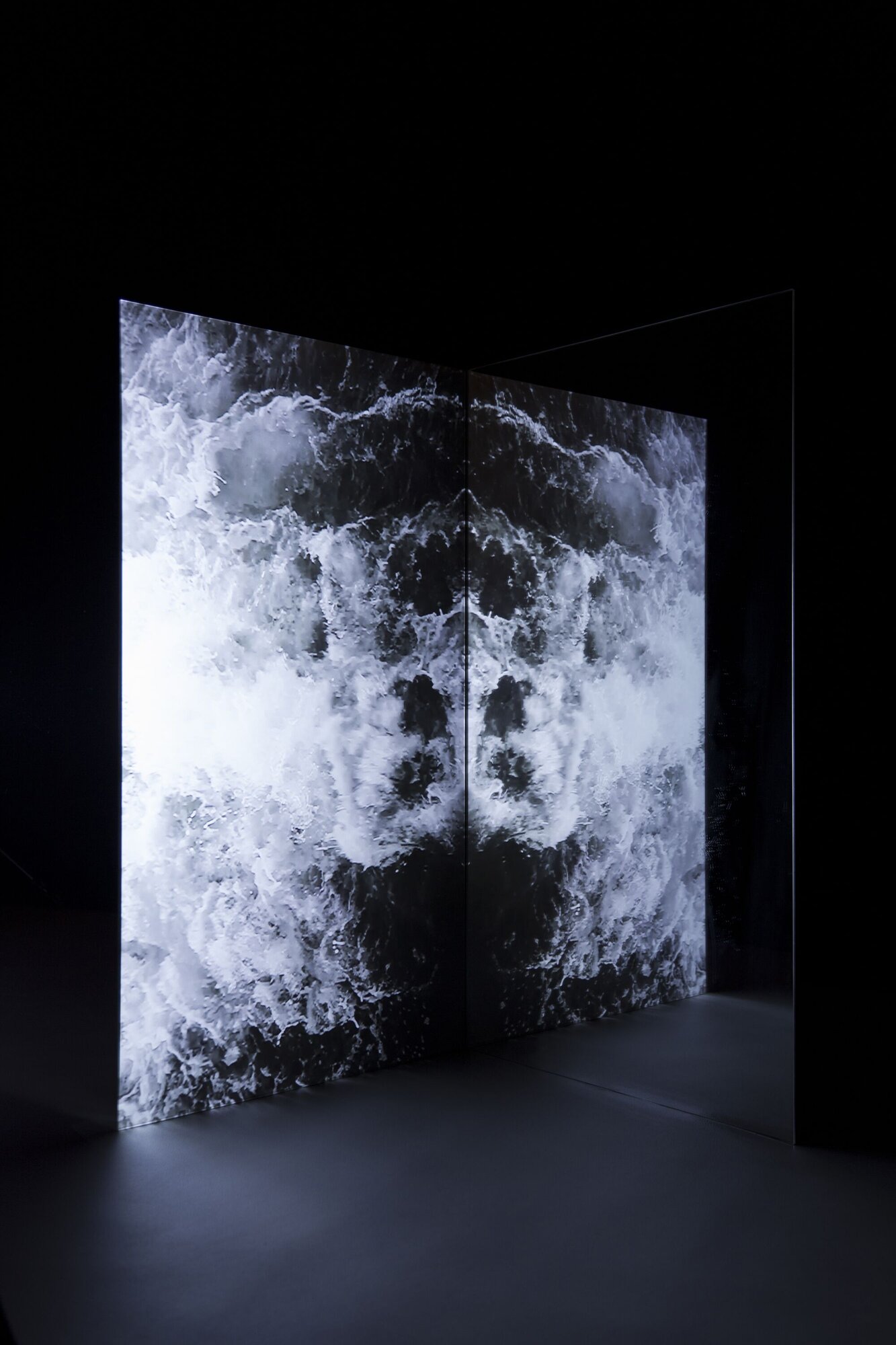
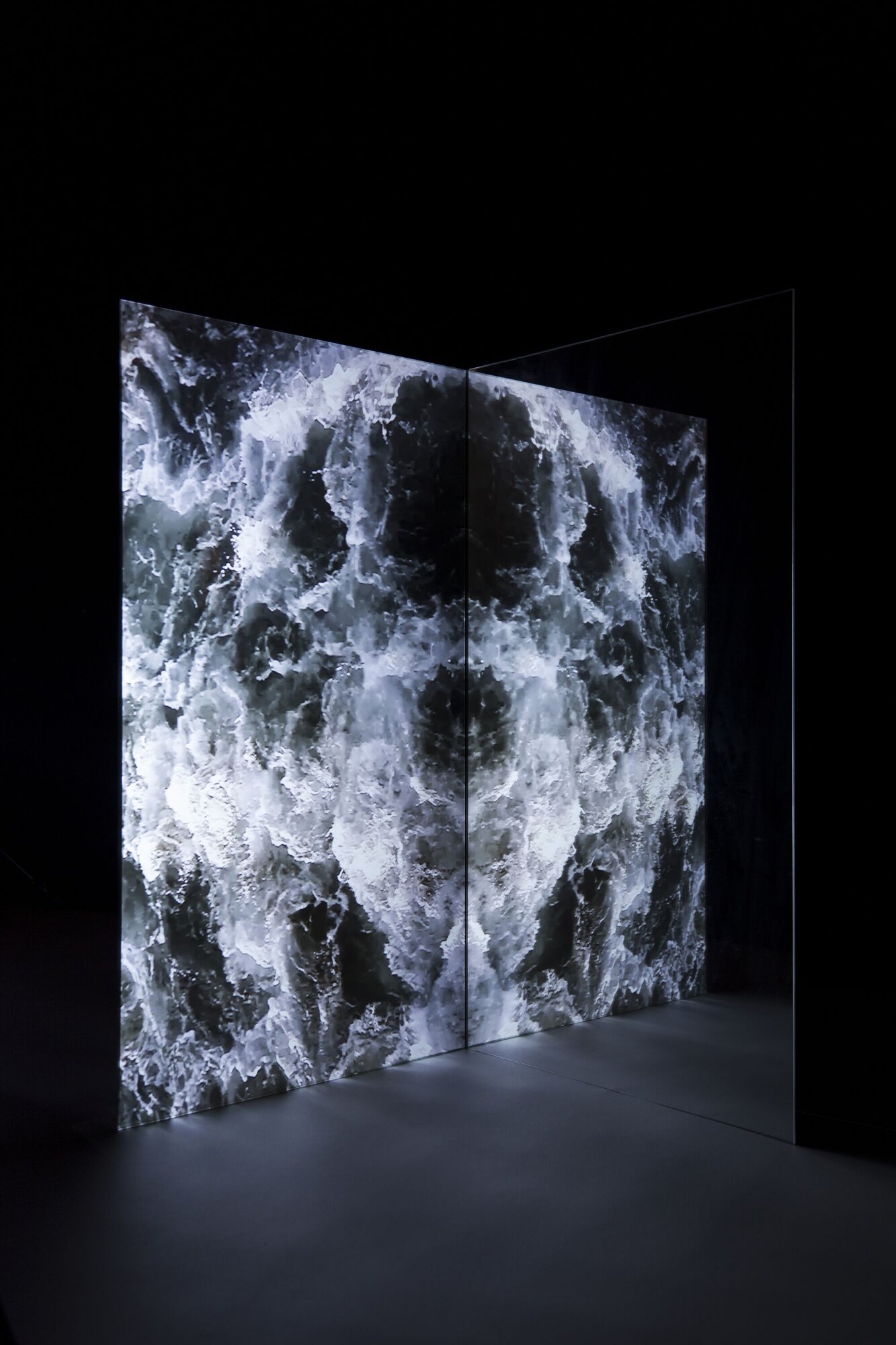
In Uncanny River (the crossing), the feeling of uncanniness has a double dimension in the spectator’s mind as well: the illusion of the duplication of the ‘Real’ and induction into a mode of perceptual suspension.
By combining the digital projection of a video image with its reflection in the mirror, this hybrid moving image system subsequently duplicates the image projected onto the screen. Thus, the reflection includes the screen itself in the same space as well as the spectator’s space and body, adding depth of field amplified by the reflection. In other words, it is through the reflection produced by the mirror that the cinematic appearance of the river crossing is perceived as real. The same sensory experience would never be possible with a double symmetrical projection of the video onto a single screen. It is its duplication by the mirror that gives the spectator a sense of three-dimensionality before a moving wall of churning water. A possible optical explanation for this phenomenon can be found in Charles Wheatstone’s (1838) conclusions on his experiments in the field of binocular vision, developed with his own invention, the mirror stereoscope; he writes ‘that the most vivid belief of the solidity of an object of three dimensions arises from two different projections of it being simultaneously presented to the mind’ (p. 380). The principle is based on the fact that our eyes project dissimilar images onto the retinas, from which our brain builds a single image of a solid three-dimensional object. Wheatstone (1838: 372) explains that the objects represented in a painting cannot be perceived in a truly three-dimensional way, no matter how virtuously painted, for both eyes simultaneously perceive similar images on the flat image. Like paintings, photographic and cinematic pictures are limited in this same way, as the three-dimensionality effect necessarily involves a separate projection on our retinas of two slightly discrepant images.
Standing before Uncanny River (the crossing) is an experience that challenges the spectator’s senses. It makes it difficult for them to clearly perceive what is real and what is imaginary, what is illusion and what is representation, and suggests the possibility of a space and time different from the natural physical order. The multiplicity of physical sensations, together with familiar cultural references, results in a complete, simultaneous experience of both strangeness and familiarity. Faced with the dynamics of eccentric and hypnotic movement, spectators may feel a mixture of vertigo and attraction, as if our bodies were in a permanent fall or flying over vertical water walls—a very intense and vivid experience, akin to the hallucination caused by the use of Salvia.[1] The experience reflects in its essence the common features of the examples given by Freud in his theory of the uncanny, later expanded and refocused by Masahiro Mori in his 1970 essay Uncanny Valley.[2] The title Uncanny River (the crossing) derives precisely from this theoretical framework. It was conceived as an intrinsic part of the work, a metaphor referring to the psychogeography of the Uncanny Valley theorem, as if in this valley, described in the context of the 1970s, a new environment flourished—hybrid, mediated by new digital technologies, information systems, and biological editing. In this (already post-human) valley flows a river that everyone can sail. Its banks are simultaneously in the real world and in the virtual one. It is a river that remains in our senses in a complete, circular way, with no beginning or end, preventing any distinction between the two worlds.
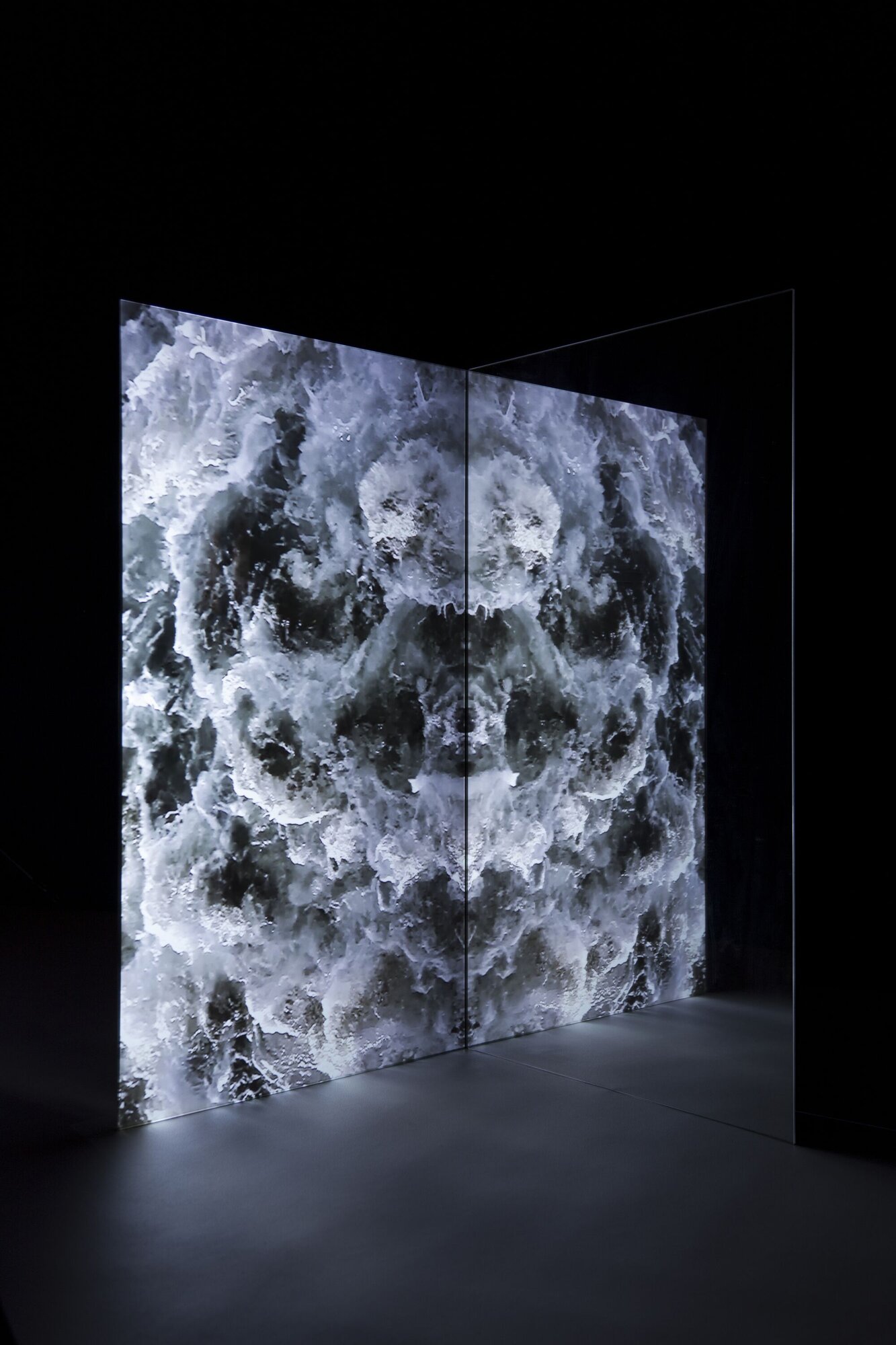
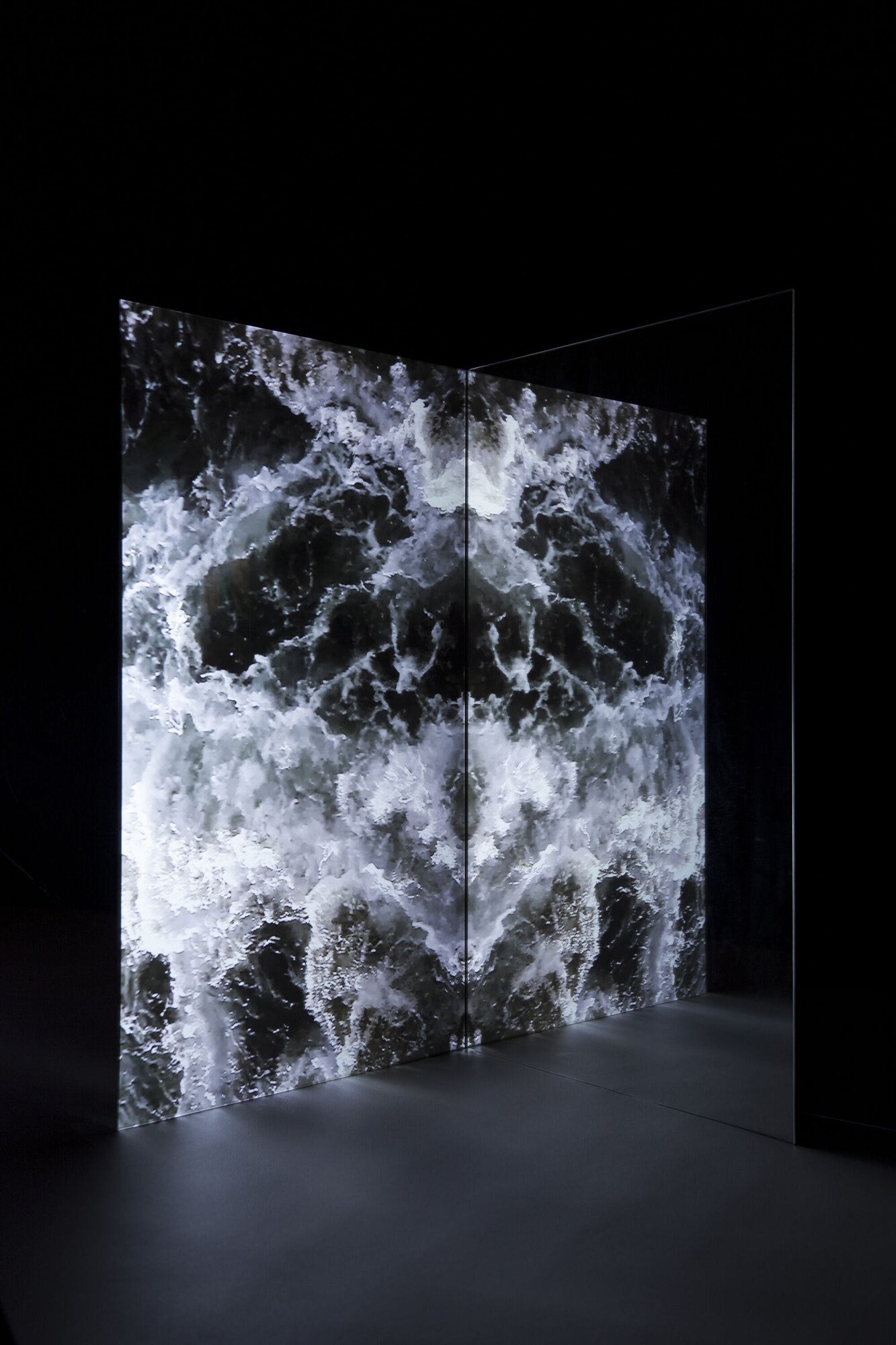
During this experience, the spectator’s mind also enters a mode of perceptual suspension, a permanent expectation of recognizing the symmetrical forms and patterns that are continually dissolving and being replaced with an endless succession of new compositions over the thirty-minute-long video, projected in an endless loop. This is probably the closest we can come to recreating Govinda’s visions as described by Hermann Hesse in Siddhartha (1922/2006). I quote Hesse here to help the reader imagine the experience of watching Uncanny River (the crossing), where the images they perceive would immediately dissolve and transform into different ones without allowing them a single moment to become aware of or classify the fantastic beings and strange forms that constantly appear:
‘He no longer saw the face of his friend Siddhartha. Instead, he saw other faces, many faces, a long series, a continuous stream of faces—hundreds, thousands, which all came and disappeared and yet all seemed to be there at the same time, which all continually changed and renewed themselves and which were yet all Siddhartha. He saw the face of a fish, […] of a newly born child, […] the face of a murderer, […] the naked bodies […] corpses stretched out, […] heads of animals—boars, crocodiles, elephants, oxen, birds. He saw Krishna and Agni. He saw all these forms and faces in a thousand relationships to each other’ (Hesse 2006: 136–7).
Unexpectedly in the dark gallery space, standing before the vertical maelstrom of images coming in and out, the sensation is one of sublime tranquillity and enlightenment. At all times, the spectator is freed from the automatic mechanism of recognizing the forms that are successively suggested to them. Without any sound or visual narrative presented in space, they are unable to make any kind of individual interpretation, described by Hermann Rorschach (1922/1951: 18) as a ‘special kind of perception.’ The experience with Uncanny River (the crossing) works differently than Rorschach’s (1922) inkblot test method, which ‘consists in the interpretation of accidental forms, that is, of non-specific forms’ (p. 17, original emphasis). In Uncanny River (the crossing), the images are liquid; they move in permanent mutation. During video editing, I adjusted the speed at which the images seen in the churning water transformed in order to interrupt the perception process’s ‘three stages: sensation, memory, and association’ as categorized by Paul Eugen Bleuler (1916/1934: 13). In Uncanny River (the crossing), the cognitive process of recognizing suggested images is interrupted somewhere between memory and association. This suspension, which is hypnotic and even pleasant, causing a feeling of detachment, also cancels out the expectation of a potential partition of the waters from the center. This ‘miracle,’ like the crossing of the Red Sea as recreated by Cecil B. DeMille (1956) in The Ten Commandments,[3] never happens, as the water continues to flow incessantly from the central axis of the installation and out of the picture. Physically unable to cross the glass panels of the mirror and the screen, the spectator may nonetheless go around the installation’s optical device and observe how the trick that induced the illusion works. When viewers pass in front of the projector, their shadows appear on the screen and are also reflected in the mirror, becoming an object and image in front of other spectators.
While the spectator’s mind remains immersed in this incessant repetition of perceptual suspension, the body becomes a kind of transitory biological receptacle, a pathway where emotions and feelings are triggered. Living and lifeless matter continually flow through the body and the world, a phenomenon that makes room for the current acceleration of human–technology hybridization systems: ‘You just replaced 100 million [cells] in the course of reading the last sentence’ (Kurzweil 2012: 246). The constant interaction of our bodies with the electronic and digital media of projection, recording, and instantaneous image transmission amplifies this phenomenon in spectators’ bodies. The spectator’s body is no longer separated from the cinema screen: it is itself the object of live transmission and of participation in the continuous exchange of visual and sound data flows in the society of new digital technologies. Uncanny River (the crossing) reveals this condition, where the present is both all that exists and all that escapes us, and for this very reason, the present is all that ceases to exist as our mind drifts between the projection of expectations and the observation of memories. It makes us wonder whether time exists or whether it flows into the future—or into the past (Borges 1936/2012: 12). The question shall remain unanswered for the time being, for between the life of the body and the life of the mind there are no longer borders that separate flesh and spirit from the virtuality of cyberspace. The installation enunciates a possible future where also in death we will remain in symbiosis with the digital world, and where the possibility of liberation is confused with complete alienation.
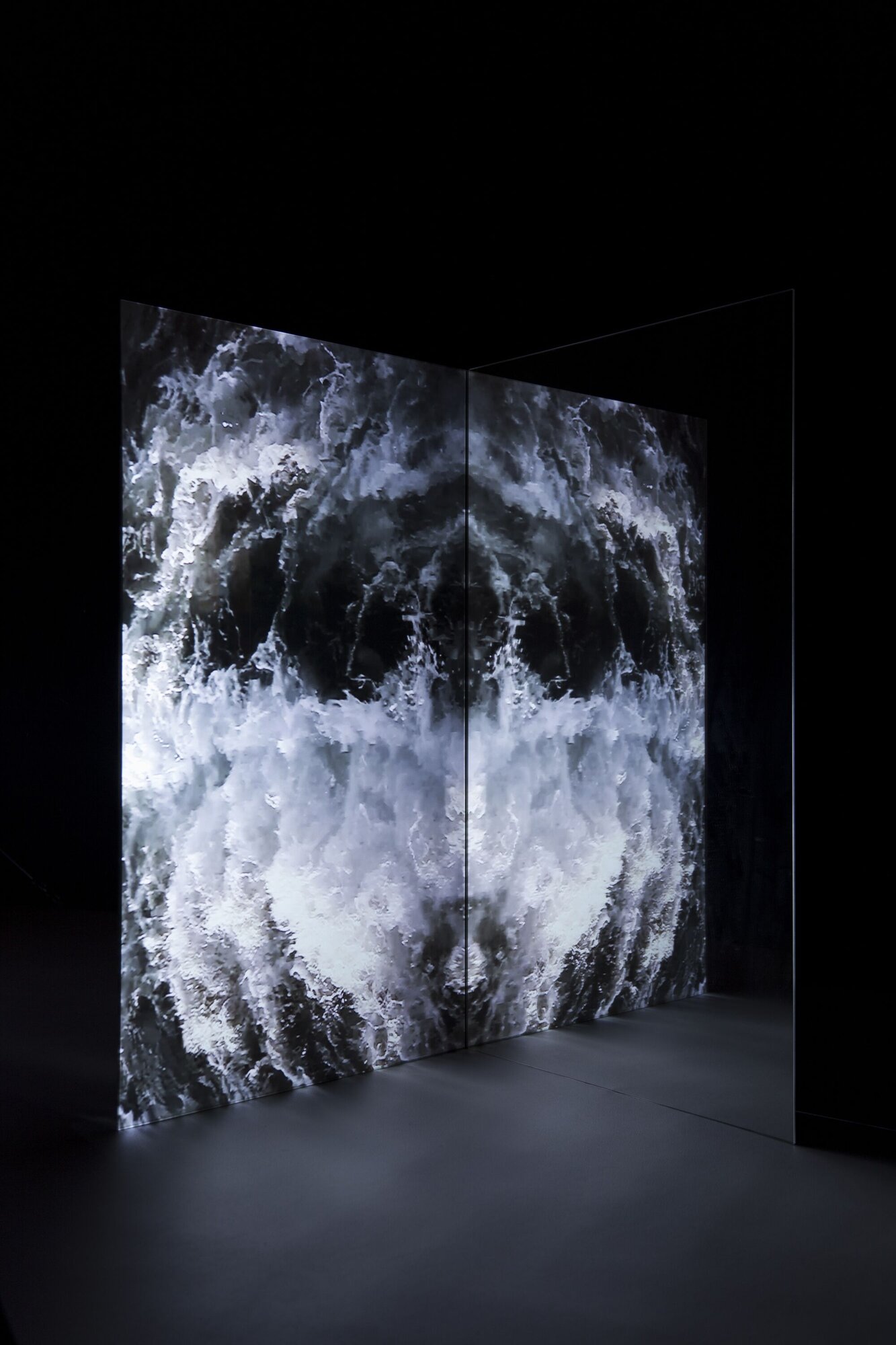
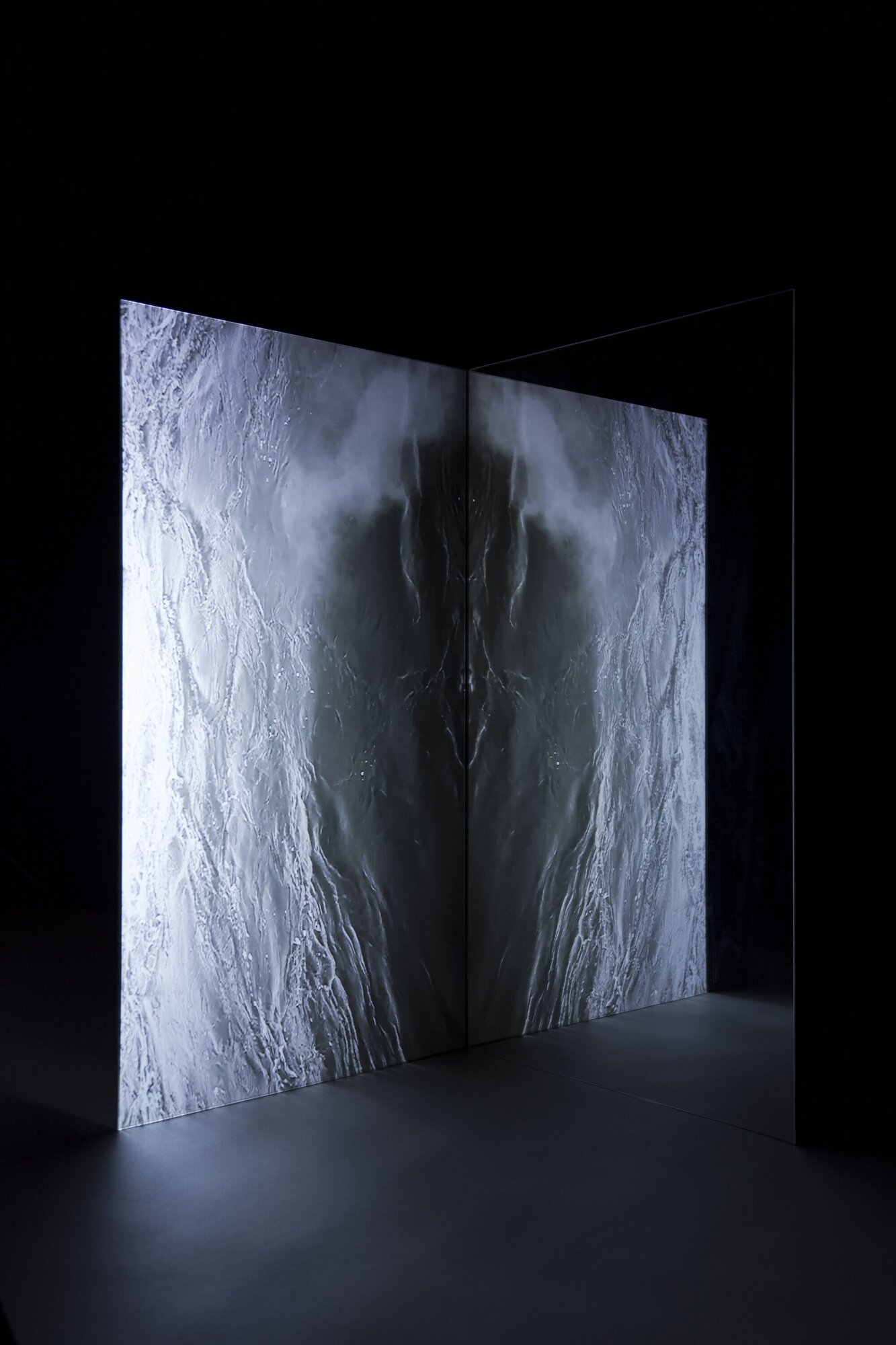
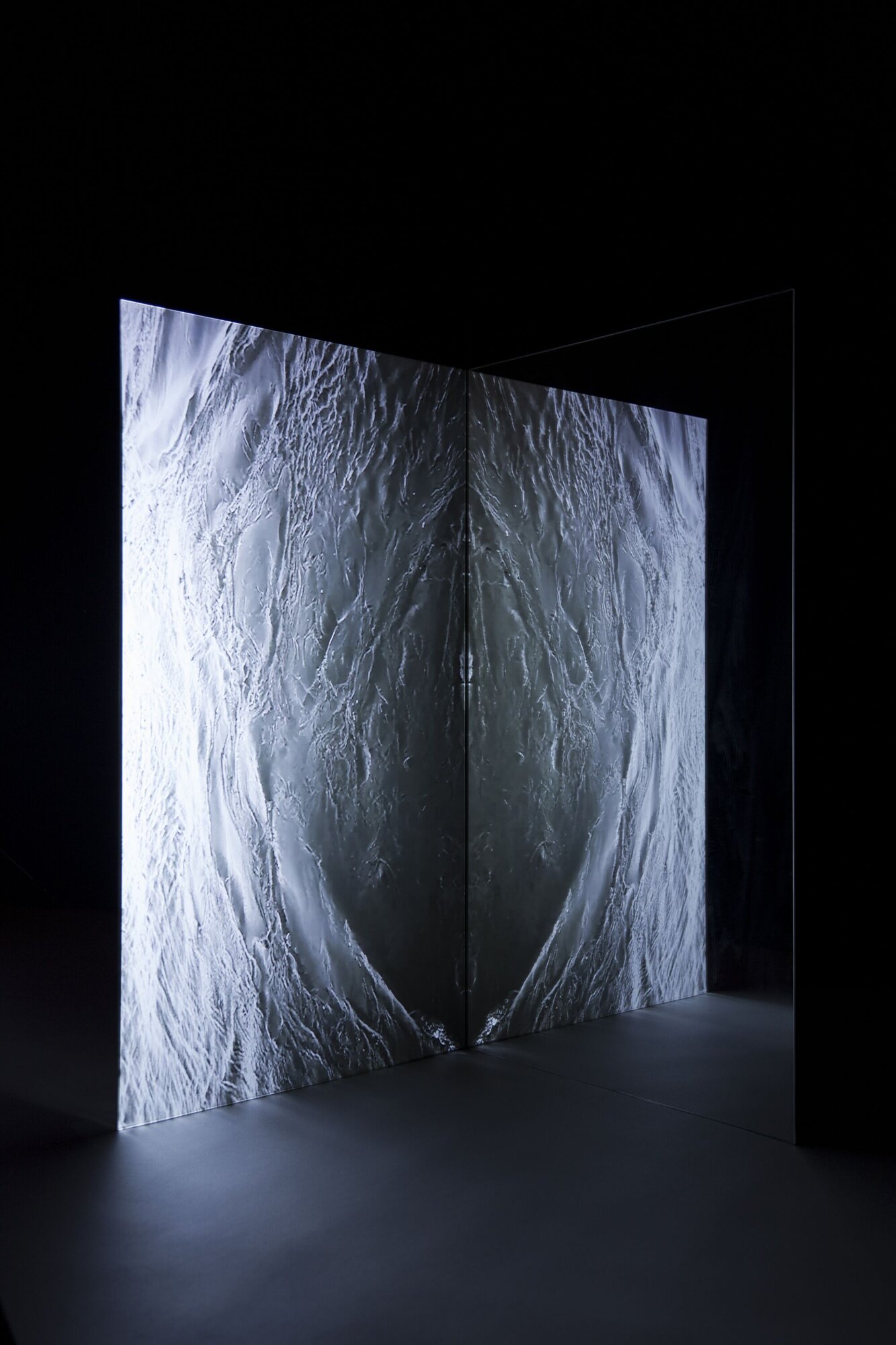
Bibliography
- DeMille CB (dir) (1956) The Ten Commandments. Paramount Pictures.
- Bleuler PE (1934) Textbook of Psychiatry, Brill AA (trans). New York, MacMillan. Originally published 1916.
- Borges JL (2012) História Da Eternidade. Lisboa, Quetzal Editores. Originally published (1936) as Historia de la eternidad.
- Burroughs WS (1987) The Western Lands. New York, Viking Penguin.
- Freud S (2022) The Uncanny, Strachey A (trans). Massachusetts Institute of Technology, web.mit.edu/allanmc/www/freud1.pdf (29.01.2022). Originally published in 1919.
- Gordon Wasson R (1963) Notes on the Present Status of Ololiuhqui and the Other Hallucinogens of Mexico. Botanical Museum Leaflets (Harvard University), 20(5): 161–212.
- Hesse H (2006) Siddhartha. New York: Random House. Originally published 1922.
- Kurzweil R (2012) How to Create a Mind: The Secret of Human Thought Revealed. New York, Penguin.
- Mori M, MacDorman K, and Kageki N (2012) The Uncanny Valley. IEEE Robotics & Automation Magazine, 19(2): 98–100.
- Rorschach H (1951) The method. In: Oberholzer E, Lemkau P, and Kronenberg B (eds), Psychodiagnostics: A Diagnostic Test Based on Perception. Bern, Hans Huber: 15–18. Originally published 1922.
- Wheatstone C (1838) XVIII. Contributions to the physiology of vision. — Part the First. On some remarkable, and hitherto unobserved, phenomena of binocular vision. Philosophical Transactions of the Royal Society of London, 128. DOI: 10.1098/rstl.1838.0019.
Footnotes:
1. Salvia divinorum (a binary nomenclature meaning ‘Salvia of the ghosts’) is a plant native to the Sierra Mazateca (Oaxaca, Mexico) capable of generating visions and hallucinations. The American anthropologist Jean Bassett Johnson published, in 1938, the first descriptions of ancient shamanic and healing rituals with ‘hierba Maria’ performed by the indigenous Mazatec people. Gordon Wasson and Albert Hofmann (who discovered LSD) collected the herb in an expedition to Mexico in 1962, which led to its future classification and compounds research.
2. The term ‘Uncanny Valley’ was first introduced by Masahiro Mori—who at the time was a professor of robotics at the Tokyo Institute of Technology—in 1970, in an article with the same title in the Japanese magazine Energy. In the article, Mori proposes a graphic model that enables us to interpret the emotional response of a human being to a robot or any other anthropomorphic ‘being’ or object. Humans’ emotional response tends to turn negative when confronted with forms related to death, amputation, prosthetics, artificial movement, etc.
3. This amazing cinematic scene is the result of a complex editing process, using multiple overlapping recordings of waterfalls, slowed down and reversed, shot in a purpose-built tank in Paramount Studios’ car park.
Author’s bio
João Biscainho is an artist and curator. His work researches the relations between art, technology, life, and representation, as well as interrogating history as a device for the production of culture and other social fictions. He is currently undertaking a PhD in Culture Studies at UCP Lisboa. He holds a BFA in Painting (Faculdade de Belas Artes da Universidade de Lisboa) and an MA in Museology (Universidade Nova de Lisboa). His artworks have been shown in Galeria Fundação Amélia de Mello, SE8 Gallery, Galeria Quadrum, Fundação Carmona e Costa, Whitechapel Art Gallery, MoCA Skopje, Luís Serpa Projectos, and other venues.
Website: www.joaobiscainho.com.


